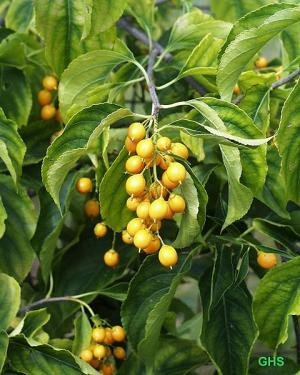American Bittersweet is Poisonous To Pets

Celastrus scandens, commonly called American Bittersweet or Bittersweet is a species of Celastrus that prefers rich, well-drained woodland soils. This plant is a sturdy perennial vine that may have twining, woody stems 30 feet or longer and an inch or more thick at the base. The stems are yellowish-green to brown and often wind around and strangle out other vegetation and small trees. In June the tiny, scentless flowers at the tips of the branches will typically bloom. Once pollinated the flowers produce colorful, orange fruits the size of a pea.
It is at this point that the relative toxicity of the plant comes into question. Some sources state that “all parts of the American Bittersweet are toxic with the highest toxicity being found in the berries”. Other sources discount the overall toxicity of the plant and consider it relatively harmless. According to the US Department of Agriculture the American Bittersweet (Celastrus scandens) plant has a toxicity level of “None”. Most sources, however, agree that the plant found use by Native Americans for a wide variety of medicinal purposes. The leaves, bark, and roots were used as aids for rheumatism, childbirth pains, gastrointestinal discomfort, skin ulcers, coughs, tuberculosis, toothaches, and even cancer. Whereas the inner bark was sometimes cooked into a thick soup in times of starvation and the fruits were reportedly used to make poisons. This would at the very least tend to substantiate the possibility that the plant has shown the capacity to have an effect upon the body. These uses, however, probably involved a poultice wherein the plant would have been mixed with other items and applied, or the plants constituents were boiled down concentrating the desired chemical components into a decoction.
Further decreasing the risk of serious intoxication by a pet is the fact that the plant contains saponins that exhibit the irritant effect of burning the mouth and throat upon ingestion. As a result only in rare cases would an animal be able to tolerate the consumption of enough plant material to cause a potentially serious poisoning situation; if it is indeed possible. There may also be a species specific component in regards to consumption of this plant. The fruit and seeds have a somewhat confirmed history of being mildly toxic for humans, while rabbits, squirrels and birds can eat them with impunity. What this means for dogs, cats or other domesticated animals such as horses, cows, sheep or goats is unknown.
Additionally there has been little research done to determine the toxicity potential of genus as a whole. Some studies have stated that Celastrus scandens contains cardenolides, although specific information on the type, amount or toxicity is lacking. To err on the side of caution this plant should be considered capable of at least causing mild to severe gastrointestinal disturbances, especially with consumption of the fruits and seeds.
In most cases of Celastrus ingestion treatment can be managed at home. The vast majority of animals will recovery naturally without human intervention. If, however, you are still concerned you may rinse and flush the mouth thoroughly with water upon finding out that your pet ingested the plant. This should remove any uningested or loose plant material from the mouth. Vomiting may then be induced to purge any plant material from the stomach. This can be accomplished by giving an emetic such as 3% hydrogen peroxide orally at a dose rate of 1 teaspoon per 10 lbs of body weight. After vomiting, the mouth should again be rinsed and flushed thoroughly with water to remove any irritant vomitus. In the vast majority of cases the pet will make a full recovery within 4 to 24 hours of ingestion.
In cases where the pet is experiencing more severe gastrointestinal upset, persistent vomiting, and diarrhea, they should be monitored carefully for signs of dehydration and provided fluid therapy if needed. While not practical in a home or field setting gastric lavage and the administration of activated medical charcoal will help to both purge and neutralize any toxins. As the charcoal passes through the digestive system, toxins are trapped in the charcoal so that when the charcoal passes from the patient, the toxins are expelled as well. If the pet is becoming dehydrated it is advisable that you take it to the vet as electrolyte replacement may be necessary. In the event your pet is suffering an irritant reaction where there is obvious oral swelling it may be advisable to give the pet an antihistamine, such as diphenhydramine (Benadryl). This will help to reduce/prevent swelling, discomfort and avoid potential blockages of the airway related to the body’s inflammatory response. Typical dose rates are 2 to 4mg/kg by mouth or intramuscularly every 8 hours as needed.
To alleviate the gastrointestinal upset Kapectolin may be given at a dose rate of 1 to 2 ml/kg four times a day. Kapectolin provides a coating action that protects the stomach lining. Sucralfate may also be used for gastrointestinal irritation as it reacts with the acids in the stomach to form a paste-like material capable of acting as a barrier between the stomach and its contents. Sucralfate is typically given to dogs weighing more the 60lbs: 1g every 6 to 8 hours; for dogs under 60 lbs: 0.5g every 6 to 8 hours; Cats: 0.25g every 8 to 12 hours to reduce irritation of the stomach and intestines.
If the airway becomes blocked due to swelling the pet should be kept under observation at a veterinary office until the swelling abates and the animal is breathing normally. Prevent further ingestion of the plant and consult a veterinarian.




